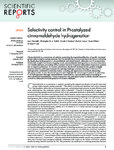Selectivity control in Pt-catalyzed cinnamaldehyde hydrogenation
| dc.contributor.author | Durndell, LJ | |
| dc.contributor.author | Parlett, CMA | |
| dc.contributor.author | Hondow, NS | |
| dc.contributor.author | Isaacs, MA | |
| dc.contributor.author | Wilson, K | |
| dc.contributor.author | Lee, AF | |
| dc.date.accessioned | 2020-05-25T09:45:35Z | |
| dc.date.available | 2020-05-25T09:45:35Z | |
| dc.date.issued | 2015 | |
| dc.identifier.issn | 2045-2322 | |
| dc.identifier.issn | 2045-2322 | |
| dc.identifier.other | 9425 | |
| dc.identifier.uri | http://hdl.handle.net/10026.1/15700 | |
| dc.description.abstract |
<jats:title>Abstract</jats:title><jats:p>Chemoselectivity is a cornerstone of catalysis, permitting the targeted modification of specific functional groups within complex starting materials. Here we elucidate key structural and electronic factors controlling the liquid phase hydrogenation of cinnamaldehyde and related benzylic aldehydes over Pt nanoparticles. Mechanistic insight from kinetic mapping reveals cinnamaldehyde hydrogenation is structure-insensitive over metallic platinum, proceeding with a common Turnover Frequency independent of precursor, particle size or support architecture. In contrast, selectivity to the desired cinnamyl alcohol product is highly structure sensitive, with large nanoparticles and high hydrogen pressures favoring C = O over C = C hydrogenation, attributed to molecular surface crowding and suppression of sterically-demanding adsorption modes. In situ vibrational spectroscopies highlight the role of support polarity in enhancing C = O hydrogenation (through cinnamaldehyde reorientation), a general phenomenon extending to alkyl-substituted benzaldehydes. Tuning nanoparticle size and support polarity affords a flexible means to control the chemoselective hydrogenation of aromatic aldehydes.</jats:p> | |
| dc.format.extent | 9425- | |
| dc.format.medium | Electronic | |
| dc.language | en | |
| dc.language.iso | eng | |
| dc.publisher | Springer Science and Business Media LLC | |
| dc.subject | 3403 Macromolecular and Materials Chemistry | |
| dc.subject | 34 Chemical Sciences | |
| dc.subject | Nanotechnology | |
| dc.subject | Bioengineering | |
| dc.title | Selectivity control in Pt-catalyzed cinnamaldehyde hydrogenation | |
| dc.type | journal-article | |
| dc.type | Article | |
| plymouth.author-url | https://www.ncbi.nlm.nih.gov/pubmed/25800551 | |
| plymouth.issue | 1 | |
| plymouth.volume | 5 | |
| plymouth.publication-status | Published online | |
| plymouth.journal | Scientific Reports | |
| dc.identifier.doi | 10.1038/srep09425 | |
| plymouth.organisational-group | /Plymouth | |
| plymouth.organisational-group | /Plymouth/Faculty of Science and Engineering | |
| plymouth.organisational-group | /Plymouth/Faculty of Science and Engineering/School of Geography, Earth and Environmental Sciences | |
| plymouth.organisational-group | /Plymouth/REF 2021 Researchers by UoA | |
| plymouth.organisational-group | /Plymouth/REF 2021 Researchers by UoA/UoA12 Engineering | |
| plymouth.organisational-group | /Plymouth/Users by role | |
| plymouth.organisational-group | /Plymouth/Users by role/Academics | |
| dc.publisher.place | England | |
| dcterms.dateAccepted | 2015-03-03 | |
| dc.identifier.eissn | 2045-2322 | |
| dc.rights.embargoperiod | Not known | |
| rioxxterms.versionofrecord | 10.1038/srep09425 | |
| rioxxterms.licenseref.uri | http://www.rioxx.net/licenses/all-rights-reserved | |
| rioxxterms.licenseref.startdate | 2015-03-24 | |
| rioxxterms.type | Journal Article/Review |


